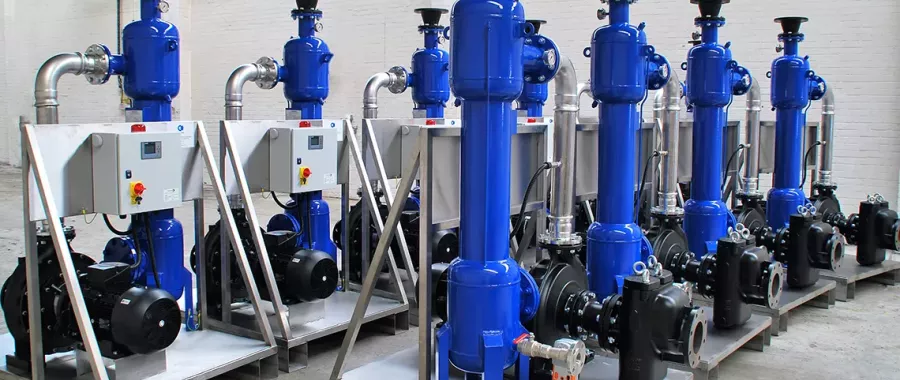Where iron and manganese deposits build up within a water system, tank or pipe, the pressure of the water system can decrease – leading to an increase in energy costs as a result of inefficiency.

Iron and manganese derive from minerals and sediments in the earth. While iron and manganese concentrations in surface water are usually low, much higher concentrations can be encountered in groundwater where water spends a longer period of time in contact with rocks.
Although natural and common, when present in a water supply, iron and manganese suspensions cause aesthetic problems including metallic taste and discolouration of water fittings and laundry. High dissolved iron and manganese concentrations can also increase chlorine demand, due to oxidation, and thus reduce the efficiency of chlorine disinfection.
Additionally, where iron and manganese deposits build up within a water system, tank or pipe, the pressure of the water system can decrease – leading to an increase in energy costs as a result of inefficiency.
Testing the water
To first understand if there is a problem, testing the water is the first step to identify if treatment is required to remove iron and manganese from water supplies.
Iron and manganese can be present in groundwater and surface water, most usually as the soluble Fe2+ and Mn2+ and the insoluble Fe3+ and Mn4+ forms, but occasionally in different oxidation states depending upon water conditions, principally pH and microbial levels. As these different states have different properties, it is important to understand which is present in the supply in order to select appropriate treatment.
Where the water is being used for drinking purposes, the UK drinking water quality regulations include national standards for iron and manganese of 200µg/l (0.2mg/l) and 50µg/l (0.05mg/l) respectively.
Treatment Method
An oxidation (aeration) process is invariably required when groundwater contains more than 1mg/l of dissolved iron or manganese.
Iron and manganese can be removed by filtration although oxidation, coagulation and sedimentation may be required for high concentrations - particularly if the metals are in dissolved form.
Treatment Process Options
Manganese Greensand:
Manganese Greensand is formulated from a glauconite greensand which is capable of reducing iron, manganese and hydrogen sulphide from water through oxidation and filtration. When the oxidising capacity power of the Manganese Greensand bed is exhausted, the bed has to be regenerated with a weak potassium permanganate (KMnO4) solution. In cases where the iron level is high, the potassium permanganate solution is continuously dosed to aid oxidation.
Chlorine Dosing:
Iron and manganese in water can also be oxidised by chlorine, converting to ferric hydroxide and manganese dioxide. The precipitated material can then be removed by filtration. The higher the amount of chlorine fed, the more rapid the reaction. When using this process on water containing organics such as Total Organic Carbon (TOC), the likelihood of creating disinfection by-products (DBPs) increases. The most common by-product is THM.
Ozone:
Ozone gas is produced in an ozone generator by high voltage electricity passing across the gas stream containing oxygen. Readily dissolved in water to provide a highly reactive oxidising disinfectant, Ozone will oxidise iron and manganese to form insoluble particulates that can easily be filtered from the water. A back-washable filter is highly recommended for these applications. Sand filters are widely used for iron and manganese removal due to the simple design and the longevity of the filter media.
Aeration:
Iron is easily oxidised by atmospheric oxygen; manganese less so, but aeration can provide the dissolved oxygen needed to convert both the iron and manganese from their soluble to insoluble forms.
Oxidation of iron and manganese with air is the most cost-effective method as there is no chemical cost. However, it is not without disadvantages. If there are high levels of manganese, the oxidation process can be slow and the reaction tank is generally required to be quite large. In addition, small changes in water quality may affect the pH of the water and the oxidation rate may slow to a point where the plant capacity for iron and manganese removal is reduced.
Birm Media:
Birm is a granular filter material which contains an active insoluble catalyst to precipitate iron and/or manganese. Under suitable conditions, the iron and dissolved oxygen in water react on contact with the Birm filter bed and, as a result, the iron is precipitated. This is a flocculent material which is filtered out in the bed of Birm. Regeneration of the media is by way of a high velocity backwash. Certain parameters need to be adhered to in order for Birm to work efficiently.
Choosing the correct method
It is important to note that there is no “one product fixes all” scenario when treating water with high iron and manganese levels, but treatment is crucial to ensuring process water is of a suitable standard for energy efficiency and equipment longevity.
It is always important to engage with a SOCOTEC water treatment specialist to ensure the correct treatment method is applied.

You might also like






Add new comment